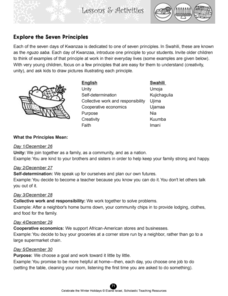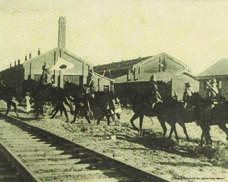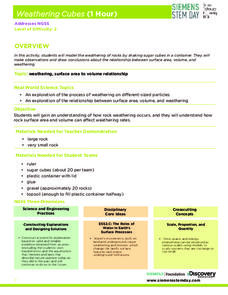NOAA
The Climate Team: Make a Solar Heat Engine
Learners investigate how solar energy is converted into heat in part two of the 10-part Discover Your Changing World series. They build and test homemade solar cookers to boil water and cook rice. Pupils consider the impact of heat...
NOAA
Why Should I Care?: Show How Increased Carbon Dioxide Makes the Ocean More Acidic
How does a change in pH affect the ocean ecosystem? Scholars explore the idea by making an acid-base indicator in part seven of the 10-installment Discover Your Changing World series. First, they explore impacts of carbon dioxide in...
NOAA
Climate, Weather…What’s the Difference?: Make an Electronic Temperature Sensor
What's the best way to record temperature over a long period of time? Scholars learn about collection of weather and temperature data by building thermistors in the fourth installment of the 10-part Discover Your Changing World series....
NOAA
The Great, Glowing Orb What You Will Do: Make a Solar Heat Engine
How is solar energy able to move wind and water to control the climate? Scholars explore the concept of solar energy in the first of 10 activities in the Discover Your Changing World series. They follow instructions to build homemade...
Exploratorium
Traveling Networks
Show your class the path to understanding graph theory. Scholars learn about basic graph theory using an activity based on the Bridges of Konigberg problem. They draw networks on the playground and decide whether it is possible to travel...
Exploratorium
Measuring and Mapping the Playground
The school playground is a great place to learn about math. Pupils measure the dimensions of a playground using baby steps and individual strides. They use their measurements to create a scale drawing of the playground by applying an...
Exploratorium
Angle Hunting
Do angles change with distance? Using a previously made tool, individuals find and measure angles on a playground. They observe that angles are the same measure regardless of the distance at which they're measured.
Exploratorium
Handy Measuring Ratio
Your hand can be a handy tool for measurement. Young mathematicians learn how to estimate the height of objects by applying similarity. They find the horizontal distance from the object where spreading their outstretched fingers results...
Exploratorium
Stride Ruler
Take it all in stride! Scholars learn to estimate distances using their strides as measurement. They take 10 steps next to a set of meter sticks and use the final distance to estimate the length of each step. Once they've found the...
Exploratorium
Making a Translation Tesselation
Make masterful art using math. An interesting activity has learners create artwork involving tesselations. First they cut out a base shape from index cards, then they apply translations to complete their masterpieces.
American Museum of Natural History
Calculating a Biodiversity Index
Biodiversity refers to the variety of animal and plant species in a specific habitat. With a collaborative activity, the habitat becomes a page from the white pages, and the species are the surnames in the book. Learners calculate the...
Pittsburgh Ballet Theatre
Peter Pan: Teacher Resource Guide
What are some of the pros and cons of staying young forever? With the Peter Pan resource, learners discover the magical world of Neverland. Scholars create advertisements that promote eternal youth, and then write persuasive pitches for...
Scholastic
Explore the Seven Principles
A lesson shines a spotlight on what makes Kwanzaa special by taking a close look at its seven principles. Gift ideas encourage scholars to make and give one to their family members. Class members celebrate heroes and role models of...
Lexington Children's Theatre
Play Guide: A Charlie Brown Christmas
What's your favorite seasonal tradition? Before viewing a stage production of A Charlie Brown Christmas, language arts students explore the music and literary themes of the story. After they have watched the show, learners compare...
First Stage
A Charlie Brown Christmas
Charlie Brown may not feel the Christmas spirit this year, but your elementary students can use the season to practice important cross-curricular skills! A set of worksheets and activities based on A Charlie Brown Christmas guide apply...
National WWII Museum
Strategic Decision Making in the Pacific Scenarios
Individuals decide what they would do when faced with a difficult military decision that puts others' safety in jeopardy. The lesson also gives the real-life outcomes of the scenarios that occurred during World War II to give them a...
Discovery Education
Smoke on the Water
How do clouds form? Learners demonstrate the formation of clouds and the water cycle by testing four different setups in a plastic bottle. They identify the key components of a cloud to help them understand the process of cloud...
Discovery Education
School of Rock
Why do rocks break down over time? Learners explore this concept by simulating physical and chemical weathering of different types of rocks. They use an abrasive to demonstrate physical weathering and acid to demonstrate chemical...
Discovery Education
By All Indications
How do people determine if something is acidic or basic? Learners make their own acid-base indicators using red cabbage and then determine the acidity and alkalinity of different substances. First, they test substances of known pH and...
Discovery Education
How's the Weather?
Young meteorologists explore different aspects of the weather while learning about measurement devices. They build instruments and then set up a weather station outside and measure temperature, humidity, air pressure, wind speed, and...
Discovery Education
Motion in the Ocean
How do temperature changes affect ocean currents? Scholars explore convection currents by demonstrating the flow of water in a baking dish. They use ice, heat, and food coloring to see currents. Then, they draw conclusions about their...
Discovery Education
Solar System Scale
Extremely large or extremely small numbers are difficult to comprehend. To help understand the massive scale of the solar system, learners complete two activities. First, they create a model to compares the size of the bodies in the...
National WWII Museum
Picturing the War in the Pacific Photos, Datelines and Captions
Young historians have the opportunity to see photos from the war in the Pacific and learn more about what each photo represents. Scholars use their knowledge of WWII to match dates and descriptions to real-life photos from the war. The...
Discovery Education
Weathering Cubes
Weathering is not necessarily a result of the weather. Scholars conduct an experiment to explore the effect of surface area and volume on the weathering process. They create their own sugar cube rocks using the same number of cubes—but...

























